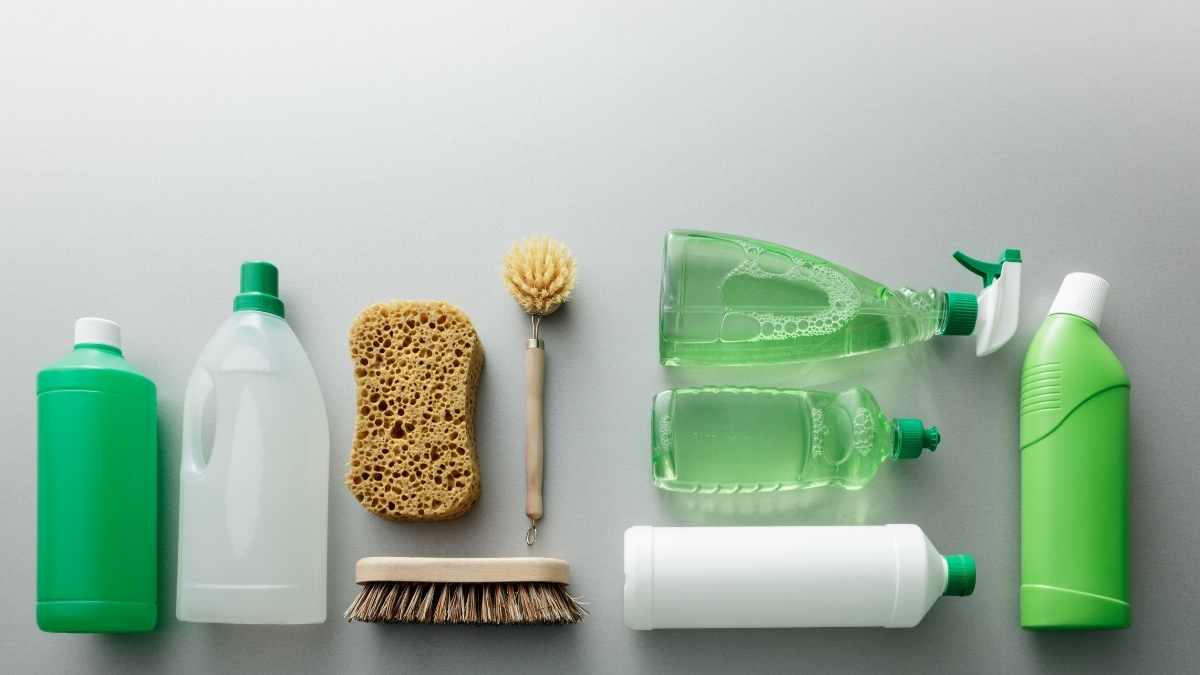Choosing eco-friendly cleaning products isn’t just about keeping your home sparkling; it’s also about making a positive impact on the environment.
Understanding what makes a cleaning product truly eco-friendly can be tricky, especially with the overwhelming number of options available.
This guide is designed to simplify your product selection process, ensuring that you can make informed decisions that align with your values of sustainability and environmental care.
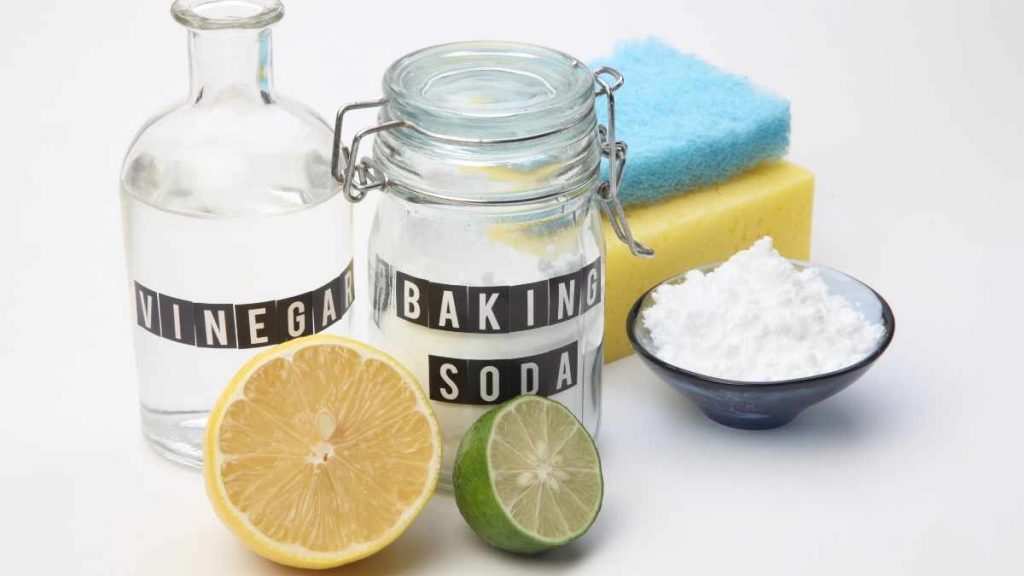
When scanning the shelves or browsing online, you might come across terms like “biodegradable,” “non-toxic,” and “organic.”
These labels can guide you towards products that are better for the planet, but it’s essential to look beyond the marketing claims.
By learning about the ingredients and their environmental impact, you’ll be better equipped to choose cleaning solutions that are genuinely beneficial to both your home and the earth.
Your journey to a more sustainable routine doesn’t have to be daunting.
With this comprehensive guide, you’ll discover how to scrutinize labels, understand eco-friendly certifications, and recognize which ingredients to avoid.
-
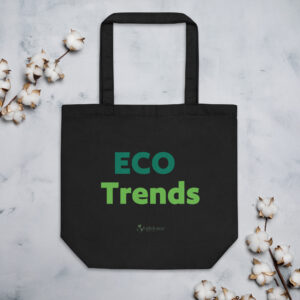
Fashionably Green and On-The-Go
£16.50 Select options This product has multiple variants. The options may be chosen on the product page -
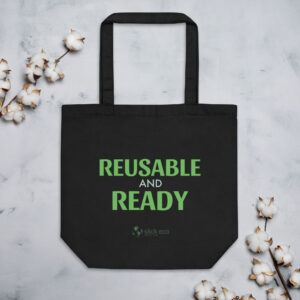
Reusable and Ready Eco-Friendly Tote Bag
£16.50 Add to cart
By educating yourself, you can transform your shopping habits and contribute to a cleaner, greener world.
Understanding Eco-Friendly Cleaning
When considering eco-friendly cleaning, it’s important to understand the terminology and the environmental implications of the products you choose.
Defining ‘Eco-Friendly’ and ‘Green’ Cleaning
Eco-friendly and green cleaning refer to using products and methods that are safe for the environment and human health.
Eco-friendly cleaning products are typically made with biodegradable ingredients and packaged in recyclable materials. Green cleaning extends beyond products to include resource-efficient practices such as reducing water usage and energy consumption during cleaning.
Environmental Impact of Cleaning Products
The cleaning products you use can have a significant environmental impact.
Conventional cleaning agents may contain chemicals that can harm aquatic life when washed down the drain, contribute to indoor air pollution, and pose health risks to you and your family.
By choosing eco-friendly products, you’re reducing the release of these harmful substances into the environment.
Important Certifications for Eco-Friendly Products
In the realm of eco-friendly cleaning, several certifications showcase a product’s environmental credentials:
- Ecolabel: This indicates that the product meets strict environmental and performance standards.
- Environmental Working Group (EWG): A nonprofit organization that rates products based on their health and environmental impact.
- Safer Choice: Managed by the EPA, it signifies that a product is safer for human health and the environment.
Looking for products with these certifications can help guide you towards more sustainable choices.
Selecting the Right Ingredients
When choosing eco-friendly cleaning products, you’ll want to consider the type of ingredients they contain. This can have a large impact on the product’s environmental footprint and cleaning efficacy.
Natural vs Synthetic Ingredients
Natural ingredients are derived from plants, minerals or animals, and are typically less harmful to the environment.
They’re often biodegradable, meaning they break down naturally without causing harm.
For example, vinegar is a natural ingredient with disinfecting properties, and baking soda is a versatile cleaner and deodorizer.
On the other hand, synthetic ingredients can be more harsh and may not break down easily, leading to potential environmental damage.
While some synthetic ingredients are effective cleaners, they might not be the best choice if you’re looking for products that align with eco-friendly practices.
Key Ingredients for Eco-Friendly Cleaning
- Vinegar: An all-natural, versatile cleaner, excellent for glass and surface cleaning.
- Baking Soda: A mild abrasive effective in scrubbing and neutralizing odors.
- Essential Oils: Not only add natural fragrance but also can possess antibacterial properties.
- Plant-based Ingredients: From coconut to corn, these are renewable and gentle on the planet.
- Biodegradable Ingredients: Ensure that once washed away, they won’t harm aquatic ecosystems.
- Recyclable Packaging: Look for products that come in packaging you can recycle, reducing waste.
Products for Every Room
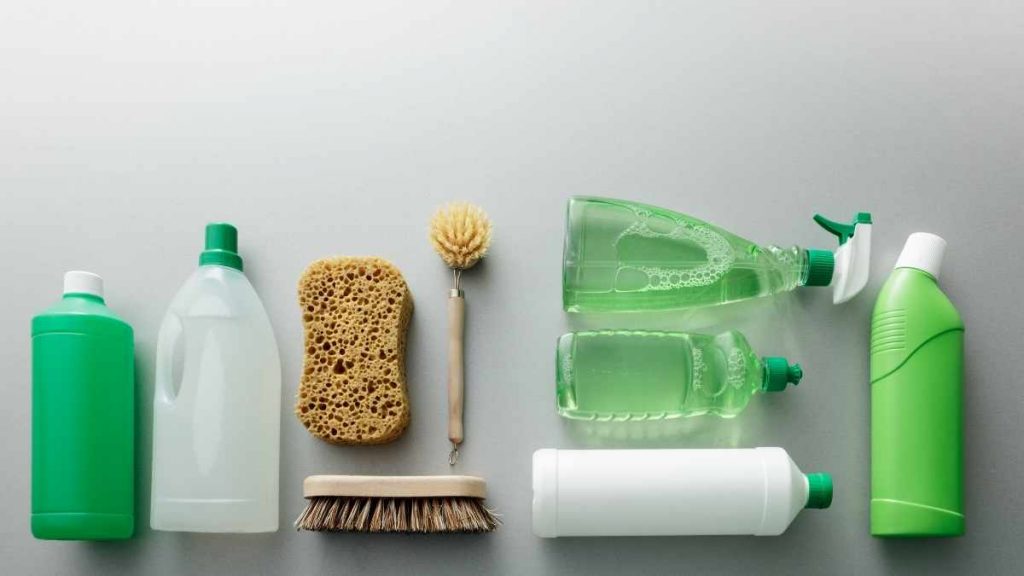
Selecting eco-friendly cleaning products for each area of your home ensures that you’re cleaning effectively while also being kind to the environment. Here’s a guide to the best types of products specifically formulated for the kitchen, bathroom, and general cleaning needs.
Kitchen Cleaners
For tackling grease and grime in the kitchen, choose a multi-surface eco-friendly cleaner that’s formulated for kitchen counters and appliances.
Baking soda based cleansers or those with citrus oils are excellent for cutting through tough kitchen messes.
Dishwasher tablets with eco-friendly credentials are available to leave your dishes spotless without harmful residues.
Recommended Products:
- Arm & Hammer Baking Soda Shaker can handle a variety of kitchen messes with ease.
- Seventh Generation’s dish liquid will keep your dishes clean without harsh chemicals.
Bathroom Cleaners
In the bathroom, you’ll want a cleaner with the ability to disinfect while being gentle on various surfaces.
Look for a bathroom cleaner with natural acids, like citric acid, which not only clean but also have natural disinfecting properties.
Eco-friendly toilet bowl and shower cleaners are also available to dissolve soap scum and water stains without the harsh fumes.
Essential Picks:
- A vinegar-based eco-friendly cleaning solution can effectively clean and deodorize your bathroom.
Laundry and General Cleaning
For laundry, an eco-friendly laundry detergent is a must to ensure your clothes get clean without introducing toxic substances into the environment.
Furthermore, consider concentrated laundry detergents to minimize packaging waste.
A versatile multi-surface cleaner can serve multiple roles in your home, from floor cleaning to dusting, while eco-friendly carpet cleaners and disinfecting wipes are handy for quick clean-ups and spot treatments.
Smart Choices:
- Tide purclean Liquid Laundry Detergent offers a plant-based formula suitable for various fabrics.
- A non-toxic carpet cleaner can refresh your carpets without leaving harmful residues behind.
Diving Deeper into Specifics
Selecting eco-friendly cleaning products isn’t just about grabbing the first “green” label you see. It’s about understanding what makes a product truly environmentally friendly and how it can effectively clean your home. Here’s how to become more informed.
Tools and Accessories for Eco-Friendly Cleaning
When gearing up for eco-friendly cleaning, consider tools made from sustainable materials.
Bamboo is a sturdy option for handles on brushes and brooms; it grows quickly and has a minimal carbon footprint.
Look for dish brushes with bamboo handles and natural bristle heads for scrubbing without plastic.
Microfiber cloths can be a powerhouse in your cleaning arsenal; they trap dust and absorb spills effectively and can be washed and reused, reducing waste.
If possible, choose cloths made from recycled materials to support recycling efforts.
- Bamboo tools: Opt for items with bamboo handles.
- Microfiber cloths: Use for dusting and cleaning surfaces.
- Recycled accessories: Seek out items made from recycled plastics and fabrics.
Understanding Labels and Ingredients Lists
Ingredient lists can be a maze of confusion, but they’re your insight into the product’s formulation.
Be wary of vague terms and focus on specifics like “biodegradable” or “plant-based”.
Sodium lauryl sulfate (SLS) is a common ingredient to be cautious of; although effective at cutting through soap scum, there are concerns about its environmental impact.
Look for clear statements about the presence of SLS or choose SLS-free products.
Remember that the longer the ingredient list, the higher the chance of including unnecessary chemicals.
- Look for clear labeling: Avoid vague terms and look for specific eco-friendly certifications.
- Ingredients: Prefer products with fewer and recognizable ingredients.
- Learn about SLS: Explore its role in cleaning products and its environmental impact.
Through mindful selection of tools and a critical eye on product labels, you can make choices that are better for the planet and your home.
Making Eco-Friendly Choices Affordable
Eco-friendly cleaning doesn’t have to mean expensive.
By opting for DIY cleaning product recipes and shopping smartly, you can embrace green cleaning without breaking the bank.
DIY Cleaning Product Recipes
Vinegar and Baking Soda: These two household items are your best friends when it comes to cleaning on a budget.
A simple mixture of vinegar and water can serve as an effective all-purpose cleaner.
For areas that need a bit more grit, like grimy tiles, create a paste with baking soda and a small amount of water.
-
All-Purpose Cleaner:
- 1 part water
- 1 part vinegar
Mix and store in a refillable spray bottle.
-
Grout and Tile Paste:
- 3 parts baking soda
- 1 part water
Apply to the surface, scrub, and rinse.
Tips for Shopping Eco-Conscious on a Budget
Bulk Buying: Purchase concentrated cleaners that can be diluted.
It’s less expensive per use and typically comes with sustainable packaging.
Refill Stations: Look for stores that offer eco-friendly cleaning product refill stations.
Refilling your bottles is often cheaper and reduces waste.
- Buy Smart:
- Inexpensive: Don’t equate price with effectiveness.
- There are affordable eco-friendly brands.
- Great Value: Compare prices by looking at the cost per use, not just the sticker price.
- Recycling: Choose products with packaging that’s recyclable to minimize your environmental impact.

